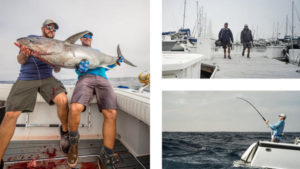Boat-Shy Bluefin Tuna Fishing Off Southern California
By Greg Stotesbury, AFTCO Tackle Sales Manager
from The Fishing Wire

Catch bluefin tuna
The past few years in Southern California we have seen epic runs of bluefin tuna as close as 3 miles off the Southern California bight. The schools of bluefin have been showing up in late spring and staying all the way to December or longer. It’s unusual for this many tuna to migrate into our waters and stay for most of the year, but these welcome visitors, in addition to our usual summer fishery for striped marlin, dorado, yellowfin tuna and yellowtail, have created a “new” and exciting opportunity not seen here since the late 1930’s. Our local Bluefin are tough to catch, but worth the effort and are the best eating of any of our local offshore species.
When the bluefin show in the California bight they can usually be located over the offshore banks and ridges, such as the 43, 182, 289 and San Clemente Island ridge in purple-blue 62 to 68-degree water. One of the keys to locating bluefin is to look for fast moving spots of terns or petrels fluttering over the surface and crashing on bait. Bluefin spend a great amount of time at the surface feeding and “breezing”. Their surface roaming, tight schooling behavior makes them particularly vulnerable to the fleets of purse seine boats from Mexico and San Pedro. By the time these fish reach local waters they have usually been harassed several times by the relentless seiners. This makes them even more boat shy and sensitive to engine noise, generators and sonar pings.
Bluefin are notoriously boat shy and difficult to hook from small private boats with smaller live bait capacities than the bigger party boats. Party boats can chum tremendous amounts of live baits and attract the bluefin to the boat, but smaller private boats must take the baits to the bluefin and use stealth tactics to get their share. This requires some modified techniques to get them to bite consistently.
After locating an area with schools of bluefin showing on top and bird schools working around them, we immediately start glassing with gyro-stabilized binoculars to find the larger spots of fish and birds. This past season you could even watch for “jumpers” (free jumping tuna) in the working bluefin schools and then target the spots with the bigger fish. Our secret to getting the bluefin to bite was to turn off all the sonar units, both up-and-down and side scanning, then position the boat above the direction the fish were working. We would then shut down the motor and wait for the bluefin to get into casting range of our fly-lined sardines and mackerel. Many times, the bluefin would shy away or go down for no apparent reason, but occasionally, the whole school would be crashing bait all around the boat in a virtual frenzy! Even when actively feeding, the super-shy bluefin would only hit a perfectly presented bait that swam as soon as it hit the surface. Bluefin tuna can be the most frustrating fish in the world, but there is nothing like the thrill of the first run of a fat Bluefin hooked on medium tackle on your own boat after a stealthy approach!
Kites have also become super popular for trolling imitation flying fish or squid through the boat shy bluefin, but we find the kite fishing to be many hours of trolling with limited bite windows. Therefore, we prefer the stealth approach with live baits. We have also had success using the kites with live baits while drifting or slow-trolling, but the conditions must be perfect and the fish willing to stay on the surface for the kites and live baits to work consistently.
Our favored Bluefin tackle is a medium-fast action, roller-guided 6.5’ to 8’ live bait rod with the best lever drag 2 speed reel available, spooled with 500 yards of 50- 80lb spectra backing, with a long 50-80lb fluorocarbon top shot. Many of the schools of Tuna run 25-75lbs, but then there are the occasional schools of 80-200-plus giants that require the lever-drag, 2-speed reels to land. You won’t land many of the 100-250lb bruiser-bluefin on the medium gear, but then you’ll never get the bite if you don’t use tackle that can fly-line a live sardine or mackerel. We had several tragedies on big tuna this past season, but we also landed a fair amount of fish to 210lbs on the medium live bait gear. We tried using 100-130lb fluorocarbon leaders, but found we got bit the best using 60-80lb pink-tinted 100% fluorocarbon with a 3/0-5/0 ringed Mutu circle hook to suit the bait size. The circle hooks reduce the bite-offs from the larger sharp-toothed Bluefin, but we still lost some of the bigger models to chewed leader after long fights on the light gear.
Due to their superior quality on the table, we handle the bluefin we catch in a special way. Our AFTCO stain protection fishing shirts help to ensure don’t we ruin our clothes in the process. Ideally, we head gaff the fish to avoid any gaff holes in the precious loins or bellies. We then immediately cut a couple of the gill arches with a pair of poultry shears, then make a small cut at the base of each side of the caudle peduncle (tail) just down to the backbone. Once the gills and tails are cut, we place the tuna head down in a bleed tank of circulating sea water and let the tuna bleed out completely before gut and gilling and slipping them into an insulated fish bag full of ice and saltwater slush. This process insures all your efforts to catch the elusive and boat-shy Bluefin Tuna are rewarded with prime sushi loins and bellies at the end of the day!